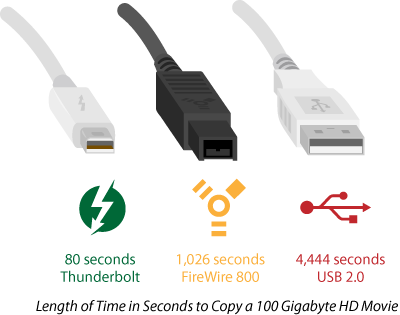-
-
products
-
resources
-
support
-
company
-
Just How Fast is Thunderbolt on a Mac?
By Steve Horton February 28, 2011firewire, interface, thunderbolt, USB1 CommentSo How Fast is Thunderbolt on a Mac?
Here is a quick illustration on the difference in speeds:

What do you think of when you think of the word Thunderbolt? Perhaps the P-47 Thunderbolt, the Air Force fighter plane used in World War II. Perhaps the Thunderbolts, the team of villains in disguise in Marvel comics. Maybe that brand-new 4G Android mobile phone. In this case, we’re referring to an interface, or connection, between a device and a PC. Intel’s Thunderbolt, formerly called Light Peak, is something introduced in late February on the new revisions of Apple’s MacBook computers. It’s meant to replace both FireWire and USB for data transfer. What that means is, you’ll be able to connect an external hard drive or video camera or disc drive via Thunderbolt, and stream data (such as video) from the device to your PC at incredible speeds.
How incredible? The first round of Thunderbolt cables can move data in both directions at the same time at 10 gigabits per second, with future cables promising speeds up to 100 gigabits per second.
Those are just numbers, though. Let’s put that into perspective. Right now you’ve likely got USB 2.0 ports on your machine. Those can only do between 120 and 180 megabits per second, or .11 to .18 gigabits. That’s 100 times slower than Thunderbolt! If you’ve got a FireWire port on the back of your desktop PC (I do; I use it to copy video from my old, tape-based video camera), it’s a little better: it can do up to 800 megabits per second under ideal conditions. That’s still .78 gigabits per second, or about 12.8 times slower than Thunderbolt.
The upcoming USB 3.0 technology, which still hasn’t really been implemented in anything yet, can reach up to about 3.2 gigabits per second. Promising, but still three times slower than Thunderbolt.
So you know the numbers; now what does this mean in practical terms? Tech website Engadget was able to use a hard drive with a Thunderbolt port on it to stream three 1080p movie clips to a computer — at the same time! That’s tremendous.
The big drawback with this new technology is that it requires specialized internal chips to control it; it’s not simply a matter of buying a card for your PC with one of those ports on it, as you might for FireWire. Only new Macs have these chips for now, but Intel says there’s no exclusive; if this new technology takes off, and there’s a good chance it might, look for PCs and hard drives and cameras with Thunderbolt on them coming your way very quickly.
Keep an eye out for the Thunderbolt technology coming to PCs later this year. If you need to move huge amounts of data very quickly, such as streaming video, and you’ve been frustrated by the USB or FireWire bottleneck, this is definitely one solution. As long as it’s not too expensive.
Was this post helpful?YesNoFree Driver Updates
Update your drivers in less than 2 minutes to enjoy better PC performance - Free.
Free Driver Updates
Update your drivers in less than 2 minutes to enjoy better
PC performance - Free.
Didn't find your answer?Ask a question to our community of experts from around the world and receive an answer in no time at all.most relevant recent articles Pin It on Pinterest
